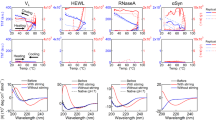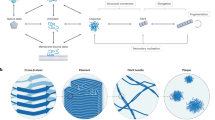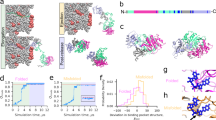Abstract
Protein aggregation is frequently observed as a major side-reaction of protein folding. We present quantitative models explaining the formation of aggregates during protein folding in vitro and in vivo on the basis of a kinetic competition between correct folding and aggregation reactions. Both models are in good agreement with experimental data. The model implies that, in vitro, the yield of native protein obtained upon refolding is determined by the rates of the competing first order folding and second order aggregation reactions. Therefore, at high protein concentrations aggregation dominates over folding and leads to the formation of insoluble protein. For in vivo protein synthesis, the model shows that the yield of native protein is only dependent on the rate of folding, on the rate of aggregation and on the rate of protein synthesis. In the cell, several mechanisms, including “folding helpers” seem to have evolved, which influence these processes and thereby prevent unproductive side reactions.
This is a preview of subscription content, access via your institution
Access options
Subscribe to this journal
Receive 12 print issues and online access
$209.00 per year
only $17.42 per issue
Buy this article
- Purchase on Springer Link
- Instant access to full article PDF
Prices may be subject to local taxes which are calculated during checkout
Similar content being viewed by others
References
Jaenicke, R. 1987. Folding and association of proteins. Prog. Biophys. Mol. Biol. 49: 117–237.
Jaenicke, R. 1991. Protein folding: local structures, domains, subunits and assemblies. Biochemistry 30: 3147–3161.
Udgoankar, J.B. and Baldwin, R.L. 1988. NMR evidence for an early framework intermediate on the folding pathway of ribonuclease A. Nature 335: 694–699.
Roder, H., Elöve, G.A. and Englander, S.W. 1988. Structural characterization of folding intermediates in cytochrome c by H-exchange labelling and proton NMR. Nature 355: 700–704.
Udgoankar, J.B. and Baldwin, R.L. 1990. Early folding intermediate in ribonuclease A. Proc. Natl. Acad. Sci. U.S.A. 87: 8197–8201.
Creighton, T.E. 1978. Experimental studies on protein folding and unfolding. Prog. Biophys. Mol. Biol. 33: 231–297.
Brandts, J.F., Halvorson, H.R. and Brennan, M. 1975. Consideration of the possibility that the slow step in protein denaturation is due to cis-trans isomerism of proline residues. Biochemistry 14: 4953–4963.
Kiefhaber, T., Grunert, H.-P., Hahn, U. and Schmid, F.X. 1990. Replacement of a cis-proline simplifies the mechanism of ribonuclease T1 folding. Biochemistry 29: 6475–6479.
Teschner, W., Rudolph, R. and Garel, J.-R. 1987. Intermediates on the folding pathway of octopine dehydrogenase from Pecten jacobaeus. Biochemistry 26: 2791–2796.
Jaenicke, R. and Rudolph, R. 1986. Folding proteins. Meth. Enzymol. 131: 218–250.
Zettlmeißl, G., Rudolph, R. and Jaenicke, R. 1979. Reconstitution of lactic dehydrogenase. Noncovalent aggregation vs. reactivation. Biochemistry 18: 5567–5571.
Zetina, C.R. and Goldberg, M.E. 1980. Reversible unfolding of the ß2 subunit of Escherichia coli tryptophane syntethase and its proteolytic fragments. J. Mol. Biol. 137: 401–414.
King, J., Haase, C. and Yu, M.-H. 1987. Temperature-sensitive mutations affecting kinetic steps in protein-folding pathways, p. 109–121. In: Protein Engineering. Oxender, D. L. and Fox, C. F. (Eds.). Alan R. Liss, Inc., New York.
Rudolph, R. 1990. Renaturation of recombinant, disulfide-bonded proteins from “inclusion bodies”, p. 149–171. In: Modern Methods in Protein- and Nucleic Acid Analysis. Tschesche H. (Ed.). Walter de Gruyter, Berlin, New York.
Marston, F.A.O. 1986. The purification of eukaryotic polypeptides synthesized in Escherichia coli. Biochem. J. 240: 1–12.
Schein, C. 1989. Production of soluble recombinant proteins in bacteria. Bio/Technology 7: 1141–1149.
Schein, C. 1990. Solubility as a function of protein structure and solvent components. Bio/Technology 8: 308–317.
Kane, J.F. and Hartley, D.L. 1988. Formation of recombinant protein inclusion bodies in Escherichia coli. Tibtech 6: 95–101.
Wilkinson, D.L. and Harrison, R.G. 1991. Predicting the solubility of recombinant proteins in Escherichia coli. Bio/Technology 9: 443–338.
Cheng, T.-S.E. 1983. Increased cell bouyant densities of protein over-producing Escherichia coli cells. Biochem. Biophys. Res. Comm. 111: 104–111.
Gribskov, M. and Burgers, R.R. 1983. Overexpression and purification of the sigma subunit of Escherichia coli RNA polymerase. Gene 26: 109–118.
Mitraki, A. and King, J. 1989. Protein folding intermediates and inclusion body formation. Bio/Technology 7: 690–697.
Goldberg, M.E. and Zetina, C.R. 1980. Importance of interdomain interactions in the structure, function and stability of the F1 and F2 domains isolated from the β2-subunit of E. coli tryptophan syntethase, p. 469–484. In: Protein Folding. Jaenicke, R. (Ed.). Elsevier/North-Holland, Biomedical Press, Amsterdam, New York.
Goldberg, M.E., Rudolph, R. and Jaenicke, R. 1991. A kinetic study of the competition between renaturation and aggregation during the refolding of denatured-reduced egg white lysozyme. Biochemistry 30: 2791–2797.
Moore, J.W. and Pearson, R.G. 1981. Kinetics and Mechanism. J. Wiley and Sons, New York
Buchner, J., Schmidt, M., Fuchs, M., Jaenicke, R., Rudolph, R., Schmid, F.X. and Kiefhaber, T. 1991. GroE facilitates refolding of citrate synthase by suppressing aggregation. Biochemistry 30: 1586– 1591.
Kopetzki, E., Schumacher, G. and Buckel, P. 1989. Control of formation of active soluble or inactive insoluble baker's yeast alpha-glucosidase P1 in Escherichia coli by induction and growth temperature. Mol. Gen. Genet. 216: 149–155.
Schein, C.H. and Noteborn, M.H.M. 1988. Formation of soluble recombinant proteins in Escherichia coli is favoured by lower growth temperature. Bio/Technology 6: 291–294.
Cabilly, S. 1989. Growth at sub-optimal temperatures allows the production of functional, antigen-binding Fab fragments in Escherichia coli. Gene 85: 553–557.
Kim, P.S. and Baldwin, R.L. 1982. Specific intermediates in the folding reactions of small proteins and the mechanism of protein folding. Ann. Rev. Biochem. 51: 459–489.
Kiefhaber, T., Quaas, R., Hahn, U. and Schmid, F.X. 1990. Folding of ribonuclease T1. 1. Existence of multiple unfolded states created by proline isomerisation. Biochemistry 29: 3053–3060.
Lang, K., Schmid, F.X. and Fischer, G. 1987. Catalysis of protein folding by prolyl isomerase. Nature 329: 268–270.
Bergman, L.W. and Kuehl, W.M. 1979. Formation of an intrachain disulfide bond on nascent immunoglobulin light chain. J. Biol. Chem. 254: 8869–8876.
Bulleid, N.J. and Freedman, R.B. 1988. Defective co-translational formation of disulphide bonds in protein disulphide-isomerase-deficient microsomes. Nature 355: 649–651.
Freedman, R.B., Bulleid, N.J., Hawkins, H.C. and Paver, J.L. 1989. Role of protein disulphide-isomerase in the expression of native proteins. Biochem. Soc. Symp. 55: 167–192.
Goldberger, R.F., Epstein, C.J. and Anfinsen, C.B. 1963. Acceleration of reactivation of reduced bovine pancreatic ribonuclease by a microsomal system from rat liver. J. Biol. Chem. 238: 628–635.
Venitianer, P. and Straub, F.B. 1963. The enzymatic reduction of ribonuclease. Biochim. Biophys. Acta 67: 166–168.
Pelham, H.R.B. 1986. Speculations on the functions of the major heat shock and glucose-regulated proteins. Cell 46: 959–961.
Goloubinoff, P., Christeller, J.T., Gatenby, A.A. and Lorimer, G.H. 1989. Reconstitution of active dimeric ribulose bisphosphate carboxylase from an unfolded state depends on two chaperonin proteins and Mg-ATP. Nature 342: 884–889.
Goloubinoff, P., Gatenby, A.A. and Lorimer, G.H. 1989. GroE heat-shock proteins promote assembly of foreign prokaryotic ribulose bisphosphate carboxylase. Nature 337: 44–47.
Fischer, G. and Schmid, F.X. 1990. The mechanism of protein folding. Implications of in vitro refolding models for de novo protein folding and translocation in the cell. Biochemistry 29: 2205–2212.
Buchner, J. and Rudolph, R. 1991. Routes to active proteins from transformed microorganisms. Current Opinion in Biotechnology, In press.
Author information
Authors and Affiliations
Rights and permissions
About this article
Cite this article
Kiefhaber, T., Rudolph, R., Kohler, HH. et al. Protein Aggregation in vitro and in vivo: A Quantitative Model of the Kinetic Competition between Folding and Aggregation. Nat Biotechnol 9, 825–829 (1991). https://doi.org/10.1038/nbt0991-825
Issue Date:
DOI: https://doi.org/10.1038/nbt0991-825
This article is cited by
-
Online monitoring of protein refolding in inclusion body processing using intrinsic fluorescence
Analytical and Bioanalytical Chemistry (2024)
-
Advances in monitoring and control of refolding kinetics combining PAT and modeling
Applied Microbiology and Biotechnology (2021)
-
Heterologous expression, purification, and refolding of SRY protein: role of l-arginine as analyzed by simulation and practical study
Molecular Biology Reports (2020)
-
Refolding with Simultaneous Purification of Recombinant Serratia marcescens Lipase by One-Step Ultrasonication Process
Applied Biochemistry and Biotechnology (2020)
-
A High-Throughput Platform for the Generation of Synthetic Ab Clones by Single-Strand Site-Directed Mutagenesis
Molecular Biotechnology (2019)



